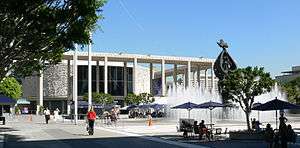New Formalism (architecture)
New Formalism is an architectural style that emerged in the United States during the mid 1950s and flowered in the 1960s. Buildings designed in that style exhibited many Classical elements including "strict symmetrical elevations"[1] building proportion and scale, Classical columns, highly stylized entablatures and colonnades. The style was used primarily for high-profile cultural, institutional and civic buildings. They were "typically constructed using rich materials such as marble, granite or man-made composites and also incorporated certain qualities of concrete that allowed for the creation of distinctive forms such as umbrella shells, waffle slabs and folded plates".[2] Edward Durrell Stone's New Delhi American Embassy (1954), which blended the architecture of the east with modern western concepts, is considered to be the symbolic start of New Formalism architecture.[3]

"Common features of the New Formalism style, include:
- Use of traditionally rich materials, such as travertine, marble, and granite or man-made materials that mimic their luxurious qualities
- Buildings usually set on a podium
- Designed to achieve modern monumentality
- Embraces classical precedents, such as arches, colonnades, classical columns and entablatures
- Smooth wall surfaces
- Delicacy of details
- Formal landscape; use of pools, fountains, sculpture within a central plaza"[3]
Notable architects
Notable examples
- McGregor Memorial Conference Center (1958)
- Pacific Science Center (1962)
- Uptown Campus, University at Albany, SUNY (1964)
- 2 Columbus Circle (1964)
- Dorothy Chandler Pavilion (1964)
- Ahmanson Theater (1967)
- United States Confluence Theater - now John H. Wood Federal Courthouse (1968)
- The Forum (1967)
- Lincoln Center for the Performing Arts (1962/69).
- Wilshire Colonnade (1970)
- John F. Kennedy Center for the Performing Arts (1971)
- World Trade Center (1973 - 2001)
- Istiqlal Mosque, Jakarta (1978)
References
- Wiffen, Marcus, American Architecture Since 1780: A Guide to the Styles, The M.I.T. Press, Cambridge Massachusetts, 1969
- "Music Center - Architecture and Design of The Music Center". musiccenter.org. Archived from the original on 2014-10-11.
- "Architectural Styles in Fullerton: New Formalism". fullertonheritage.org. Archived from the original on 2017-11-29. Retrieved 2014-12-30.
.jpg)